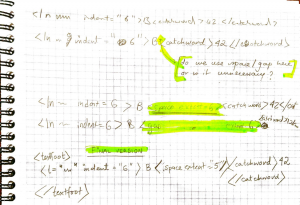In the excitingly titled “So then what happened?” Rob outlined some of the major changes that we’ve introduced to the marginalia schema, such as using specific <layer>s to differentiate between typographic text and Blake’s writing, dispensing with line numbers for the typographic text, and dividing the annotations into discrete zones with fluid spatial coordinates. Armed with these new and fascinating solutions, we decided to transcribe the marginalia BADs independently and to hold bimonthly update sessions to discuss our progress or talk about any specific problems that came up.
So far so good. As we had worked through the more complex documents to develop the schema (as is usual), we moved through the others reasonably fast and greatly congratulated ourselves on our progress. However, in the last marginalia meeting, we discovered that there are minor differences in most of our encoding decisions. Jarrod and I began the typographic layer like this:
![]()
while Shannon and Rob did this:

(We now know that we have to encode <texthead> and <textfoot> in typographic texts according to Blake Archive precedents.) Alison’s BAD looked more similar to ours (mine and Jarrod’s) except that her use of line number differs from the rest of us and she’s not entirely happy with using “justify” for the entire <lg>.
![]()
The meeting devolved into utter chaos and madness when we started discussing these and many other differences and tried to figure out the rules for correctly using <catchword>, which is a tag available in the Blake Archive DTD. Thankfully, Alana calmed us down a little by suggesting that we write down our individual ways of encoding <catchword> on a piece of paper (that she provided).

After some trial and error, urgent green highlighting, and a final word from Eric, we settled on a standardized way to encode <catchword>. We have now agreed to do the same with the other problem areas in our transcriptions, so that in the next couple of weeks we should be able to have a much more detailed and error-free (and hopefully exhaustive) marginalia schema. Alana has further promised that she might make that into a video that helps new (or just forgetful) people to follow all the steps in creating the ideal marginalia transcription, something that is certainly worth fighting for.
